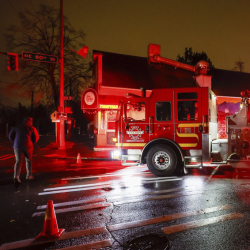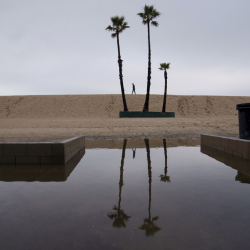 WASHINGTON (AP) -- The economy grew late last year at a pace that in normal times would suggest it's healthy.
WASHINGTON (AP) -- The economy grew late last year at a pace that in normal times would suggest it's healthy.
But the 2.8 percent annualized growth rate in the October-December quarter - the fastest pace since the spring of 2010 - isn't being cheered by most economists or investors. That's because growth would need to be much stronger to sharply reduce unemployment. And signs in the data point to slower growth ahead.
For all of last year, the economy grew just 1.7 percent. That was barely more than half the growth in 2010. The outlook for all 2012 is slightly better. The Federal Reserve estimates growth of roughly 2.5 percent for the year.
Though the economy has picked up and is far stronger than during the Great Recession, unemployment is still a high 8.5 percent. Many people remain reluctant to spend more or buy homes. Many employers are still hesitant to hire.
For the final three months of 2011, Americans spent more on vehicles, and companies restocked their shelves at a robust pace. But overall growth last quarter - and for all of last year - was held back by the sharpest cuts in annual government spending in four decades, the Commerce Department said Friday.
Several factors are expected to exert more of an economic drag this year: Cuts in military and other federal spending. A slower pace of company restocking. Weak or flat pay increases. Sluggish growth in consumer spending.
Stocks opened lower after the government reported the growth figures at 8:30 a.m. EST. The Dow Jones industrial average was down about 53 points in late-morning trading. Broader indexes were mixed.
"Overall, the pickup in growth doesn't look half as good when you realize that most of it was due to inventory accumulation," said Paul Ashworth, an economist at Capital Economics, who expects growth to slow to below 2 percent in the first three months of this year.
In the final three months of last year, consumer spending grew at a 2 percent annual rate. That's up modestly from the third quarter. Consumer spending is important because it makes up 70 percent of economic activity.
Much of the growth was powered by a 14.8 percent surge in sales of autos and other long-lasting manufactured goods.
Incomes, which have been weak all year because of high unemployment, grew at a modest 0.8 percent annual rate. That followed two straight quarters of declining incomes. But unless pay increases pick up, consumers who have dipped into savings in recent months, may pull back.
Business restocking, which can vary widely from quarter to quarter, was the greatest contributor to growth in the October-December period. It added nearly 2 percentage points to the gross domestic product, or GDP.
Government spending at all levels fell at an annual rate of 4.6 percent in the fourth quarter and 2.1 percent for the year - the biggest decline since 1971. Sweeping federal defense cuts at the beginning and end of 2011 were a major factor.
The economy is measured by GDP, which covers everything from haircuts to hotel bookings to jet fighter planes. Friday's estimate was the first of three for the fourth quarter.
Other data show that in some ways, the economy ended 2011 on a strong note. Companies invested more in equipment and machinery in December. The unemployment rate fell to 8.5 percent last month - the lowest level in nearly three years - after the sixth straight month of solid hiring.
People are buying more cars, and consumer confidence is rising. Even the depressed housing market has shown enough improvement to make some economists predict a turnaround has begun.
Ian Shepherdson, an economist at High Frequency Economics, is among the more optimistic analysts. He said he thought business investment in capital goods would be stronger and consumer spending higher this year.
Richard DeKaiser, a senior economist at Parthenon Group, expects just 2 percent annual growth in the January-March quarter. But DeKaiser says that should be the weakest quarter. He expects the economy to gain strength in each quarter and grow 2.6 percent for the entire year.
Still, many economists worry that a recession in Europe could dampen demand for U.S. manufactured goods, which would slow growth. And without more jobs and better pay, consumer spending is likely to stagnate.
The Fed signaled this week that a full recovery could take at least three more years. In response, it said it would probably not increase its benchmark interest rate until late 2014 at the earliest - a year and a half later than it had previously said.
The central bank also slightly reduced its outlook for growth this year, from as much as 2.9 percent forecast in November down to 2.7 percent. The Fed sees unemployment falling as low as 8.2 percent this year.
© 2012 The Associated Press. All rights reserved. This material may not be published, broadcast, rewritten or redistributed. Learn more about our Privacy Policy and Terms of Use.
Portland and Seattle
Free Subscription to Breaking News
Free Subscription to Breaking News






















































































































































































































































































































































